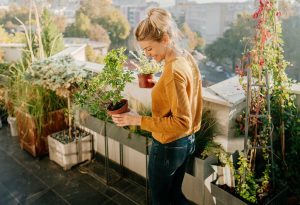
Introduction
In 2025, United States smart irrigation systems are revolutionizing how we manage water in our gardens. With concerns about water conservation becoming increasingly important, homeowners and landscapers are turning to smart garden irrigation solutions to reduce water waste while keeping plants healthy. These innovative systems use technology to monitor weather conditions, soil moisture, and plant needs, ensuring that gardens receive just the right amount of water.
This article will explore the benefits of smart irrigation systems, how they work, and why they are crucial for water conservation in your garden. Whether you’re a seasoned gardener or a beginner, understanding how these systems work can help you save water, time, and effort while creating a lush, sustainable outdoor space.
What Is a Smart Irrigation System?

A smart irrigation system is an advanced watering system that uses sensors, weather data, and automation to optimize water usage in gardens, lawns, and landscapes. Unlike traditional irrigation systems that water on a fixed schedule, smart systems adjust the watering cycle based on factors like soil moisture, temperature, humidity, and rainfall predictions.
By using smart garden irrigation, you can ensure that your plants get the exact amount of water they need, reducing waste and improving the health of your garden.
Key Features of Smart Irrigation Systems:
- Soil Moisture Sensors: Detect when the soil is dry and need watering.
- Weather Integration: Connects to weather forecasts to avoid watering during rain or high humidity.
- Automated Scheduling: Adjusts watering times based on real-time data.
- Remote Control: Many smart irrigation systems can be controlled remotely via smartphone apps.
These features help create a water-efficient irrigation system that can save a significant amount of water while maintaining a healthy garden.
Benefits of Smart Irrigation Systems for Your Garden

1. Water Conservation
One of the primary benefits of smart irrigation systems is their ability to conserve water. Traditional sprinklers often water lawns even when it’s raining or when the soil already has sufficient moisture. Smart systems, on the other hand, monitor the soil and weather conditions, ensuring that only the necessary amount of water is used. This leads to a significant reduction in water waste and water shortage and helps conserve this precious resource.
2. Cost Savings
Using automated garden irrigation systems can also lead to savings on your water bill. Because these systems optimize water usage, you’ll use less water overall, lowering your utility costs. While the initial investment in a smart irrigation system may be higher, the long-term savings make it a worthwhile investment.
3. Healthier Plants
Plants thrive when they receive the right amount of water, not too much or too little. Smart irrigation systems take the guesswork out of watering and ensure that your plants are watered appropriately. Overwatering can lead to root rot, while underwatering can stress plants. By delivering the correct amount of water, smart systems help your plants grow stronger and healthier.
4. Time and Effort Savings
Traditional irrigation systems require manual adjustments and monitoring, which can be time-consuming. Smart irrigation systems automate the entire process, meaning you can set it and forget it. Once set up, the system adjusts watering schedules, water savings and amounts based on real-time data, allowing you to spend less time on maintenance and more time enjoying your garden.
5. Environmentally Friendly
Water conservation is not only about saving money but also about helping the environment. With water-efficient irrigation systems, you contribute to reducing the strain on local water resources. This is especially important in areas where water scarcity is a concern. By optimizing water usage, you play a role in promoting sustainable gardening practices.
How Do Smart Irrigation Systems Work?

Smart irrigation systems are designed to gather data from various sources to make decisions on when and how much to water. Here’s a breakdown of how these systems work:
1. Sensors and Data Collection
The system uses soil moisture sensors placed in the garden or lawn. These sensors measure the moisture content of the soil and send this data to the irrigation controller. Some systems also include temperature and humidity sensors to get more accurate data.
2. Weather Integration
Smart irrigation systems are connected to weather data services, such as local weather stations or weather apps. By accessing real-time weather forecasts, the system can adjust watering schedules based on predicted rainfall. For example, if rain is expected, the system will skip or reduce watering.
3. Automated Watering Scheduling
Using the data from soil sensors and weather forecasts, the system automatically adjusts the watering schedule. If the soil moisture is low, the system will increase the watering duration or frequency. If the soil is sufficiently moist, it may skip watering entirely. This reduces overwatering and ensures your garden gets the exact water it needs.
4. Remote Access and Control
Many smart irrigation systems come with smartphone apps that allow you to control the system remotely. This means you can adjust the watering schedule from anywhere, monitor water usage, and receive notifications when maintenance is needed.
Choosing the Right Smart Irrigation System for Your Garden

When selecting a smart irrigation system for your garden, consider these factors:
1. Size of Your Garden
Make sure the system you choose is designed to cover the size of your garden or lawn. Some systems are designed for small gardens, while others can handle larger properties.
2. Connectivity
Check whether the system is compatible with your home’s Wi-Fi network or if it requires a separate connection. Many modern systems integrate with smart home platforms like Google Home or Amazon Alexa.
3. Ease of Installation
Some smart irrigation systems are easy to install by yourself, while others may require professional installation. If you’re comfortable with DIY projects, look for a system that includes clear instructions and user-friendly components.
4. Customization and Flexibility
Choose a system that allows you to customize watering schedules and adjust settings for different zones in your garden. Some systems offer advanced features like adjustable watering times for different plants or garden areas.
5. Budget
Consider your budget when selecting a smart irrigation system. While higher-end models may have more features, there are plenty of affordable systems that offer the essential functions for efficient water management.
Future of Smart Irrigation Systems Beyond 2025

Looking ahead, the future of smart irrigation technology systems is exciting and full of potential. In the coming years, these systems will become even more efficient and user-friendly, with advancements in AI and machine learning allowing for even better predictions of water needs. Future systems may automatically adjust to long-term weather patterns and integrate with other smart home devices for a fully connected experience. New sensor technology will make them more precise, able to detect individual plant needs more accurately. As sustainability becomes a larger focus, smart irrigation systems will continue to play a key role in reducing water waste and supporting eco-friendly gardening practices around the world.
Comparative Table: Popular Smart Irrigation Systems for 2025
| System | Features | Best For | Price Range |
|---|---|---|---|
| Rachio 3 Smart Sprinkler | Weather integration, remote control, zone management | Small to large yards | $150 – $250 |
| RainMachine Mini-8 | Wi-Fi enabled, advanced scheduling | Water-saving, budget-friendly systems | $100 – $150 |
| Gardena Smart System | Soil moisture sensors, mobile app control | European gardens, easy installation | $200 – $300 |
| Netro Smart Sprinkler | Cloud-based weather data, 8 zones control | Eco-conscious gardeners, large lawns | $150 – $250 |
Conclusion
Smart irrigation systems are revolutionizing how we manage water in gardens. In 2025, these systems are more efficient, customizable, and environmentally friendly than ever. By using real-time data, weather forecasts, and water source sensors, these systems ensure that gardens receive the exact amount of water needed, reducing water consumption and promoting healthy growth.
Investing in a smart garden irrigation system can save you time, money, and effort, all while contributing to water conservation. Whether you have a small garden or a large lawn, there’s a solution out there that can meet your needs and help you maintain a beautiful, sustainable outdoor space.




























